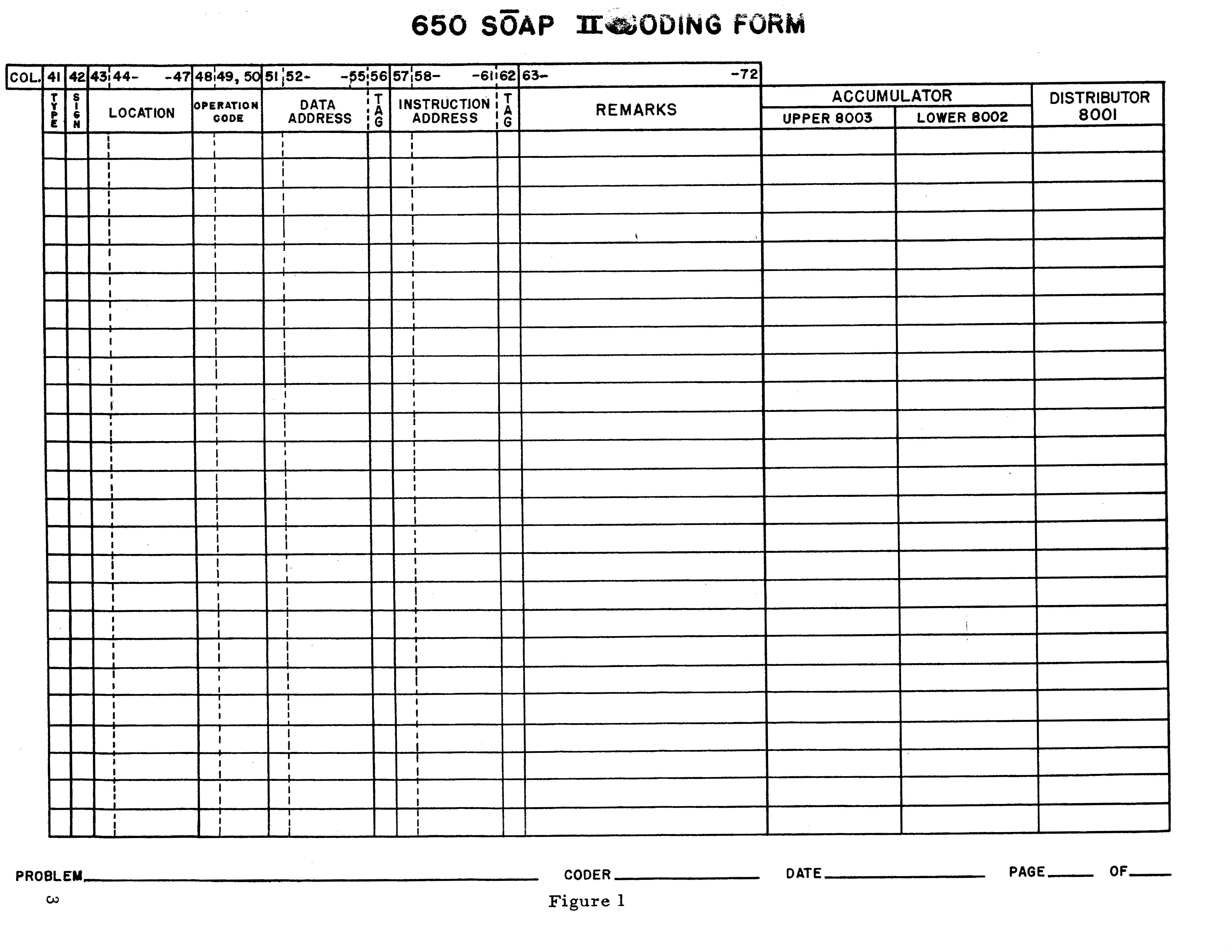Symbolic Optimal Assembly Program on:
[Wikipedia]
[Google]
[Amazon]
 The Symbolic Optimal Assembly Program (SOAP) is an assembler for the
The Symbolic Optimal Assembly Program (SOAP) is an assembler for the
SOAP at the Online Historical Encyclopaedia of Programming Languages
1955 software Assemblers IBM software Assembly language software {{compu-lang-stub
 The Symbolic Optimal Assembly Program (SOAP) is an assembler for the
The Symbolic Optimal Assembly Program (SOAP) is an assembler for the IBM 650
The IBM 650 Magnetic Drum Data-Processing Machine is an early digital computer produced by IBM in the mid-1950s. It was the first mass-produced computer in the world. Almost 2,000 systems were produced, the last in 1962, and it was the firs ...
Magnetic Drum Data-Processing Machine, an early computer
A computer is a machine that can be Computer programming, programmed to automatically Execution (computing), carry out sequences of arithmetic or logical operations (''computation''). Modern digital electronic computers can perform generic set ...
first used in 1954. It was developed by Stan Poley at the IBM Thomas J. Watson Research Center. SOAP is called "Optimal" (or "Optimum") because it attempts to store generated instructions on the storage drum to minimize the access time from one instruction to the next. SOAP is a multi-pass assembler, that is, it processes the source program more than once in order to generate the object program.
The first version of SOAP was succeeded by SOAP II in 1957, which supported additional hardware features such as index register
An index register in a computer's central processing unit, CPU is a processor register (or an assigned memory location) used for pointing to operand addresses during the run of a program. It is useful for stepping through String (computer science ...
s and magnetic core memory
In computing, magnetic-core memory is a form of random-access memory. It predominated for roughly 20 years between 1955 and 1975, and is often just called core memory, or, informally, core.
Core memory uses toroids (rings) of a hard magneti ...
, then SOAP IIA in 1958, SOAP 2L, SOAP 2L Tape, SOAP 4000, and SOAP 42 in 1961. SOAP was used as a backend to the FOR TRANSIT compiler in 1957.
Donald Knuth
Donald Ervin Knuth ( ; born January 10, 1938) is an American computer scientist and mathematician. He is a professor emeritus at Stanford University. He is the 1974 recipient of the ACM Turing Award, informally considered the Nobel Prize of comp ...
independently produced versions named SOAP III in 1958 and SUPERSOAP in 1959 at Case Institute of Technology, now part of Case Western Reserve University
Case Western Reserve University (CWRU) is a Private university, private research university in Cleveland, Ohio, United States. It was established in 1967 by a merger between Western Reserve University and the Case Institute of Technology. Case ...
in Cleveland, Ohio
Cleveland is a city in the U.S. state of Ohio and the county seat of Cuyahoga County, Ohio, Cuyahoga County. Located along the southern shore of Lake Erie, it is situated across the Canada–United States border, Canada–U.S. maritime border ...
. The US National Bureau of Standards
The National Institute of Standards and Technology (NIST) is an agency of the United States Department of Commerce whose mission is to promote American innovation and industrial competitiveness. NIST's activities are organized into physical sc ...
, under the direction of Herbert Howe, also wrote a version of SOAP, called ISOPAR, said to significantly improve optimization.
Optimization
The IBM 650 uses a magnetic drum as main storage. The drum holds up to 4,000 words and rotates at 12,500 revolutions per minute (RPM), 4.8 msec per rotation, or average access time of 2.4 msec. "If you placed your instructions sequentially onto the drum, you would have to wait for a complete rotation of the drum before the CPU could obtain the next instruction. Since many instructions on the 650 could execute in around 3 milliseconds, you would try to optimize your code by placing the instructions on the drum in such a way that it would not take the drum a full revolution to access your next instruction." Each instruction contains the address of the next instruction to execute; instead of a sequential array of instructions the memory appears to be a linked list. SOAP optimizes by placing instructions to be executed sequentially in locations around the drum such that the next instruction is available as soon as possible after the current instruction finishes. This optimization was said to make the assembled programs "run as much as six or seven times faster."SOAP features
Pseudo-operations
SOAP II supports the following pseudo-operations (assembly directives):Comments
Each source card can contain up to ten characters of comments in columns 63–72. For longer comments, up to thirty characters may be entered on a Comments Card (''Type 1'', '1' in column 41) in columns 43–72References
External links
SOAP at the Online Historical Encyclopaedia of Programming Languages
1955 software Assemblers IBM software Assembly language software {{compu-lang-stub